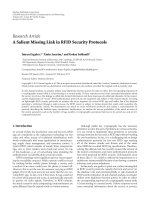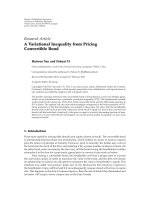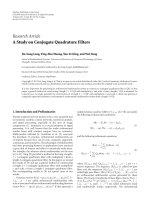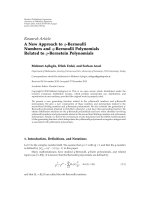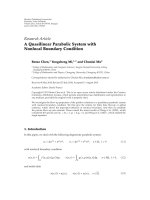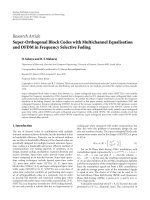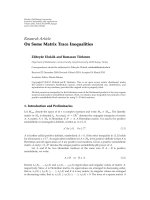Báo cáo hóa học: " Research Article A Hilbert-Type Linear Operator with the Norm and Its Applications" pdf
Bạn đang xem bản rút gọn của tài liệu. Xem và tải ngay bản đầy đủ của tài liệu tại đây (541.02 KB, 18 trang )
Hindawi Publishing Corporation
Journal of Inequalities and Applications
Volume 2009, Article ID 494257, 18 pages
doi:10.1155/2009/494257
Research Article
A Hilbert-Type Linear Operator with the Norm and
Its Applications
Wuyi Zhong
Department of Mathematics, Guangdong Institute of Education, Guangzhou, Guangdong 510303, China
Correspondence should be addressed to Wuyi Zhong,
Received 9 February 2009; Accepted 9 March 2009
Recommended by Nikolaos Papageorgiou
A Hilbert-type linear operator T :
p
φ
→
p
ψ
is defined. As for applications, a more precise operator
inequality with the norm and its equivalent forms are deduced. Moreover, three equivalent
reverses from them are given as well. The constant factors in these inequalities are proved to be
the best possible.
Copyright q 2009 Wuyi Zhong. This is an open access article distributed under the Creative
Commons Attribution License, which permits unrestricted use, distribution, and reproduction in
any medium, provided the original work is properly cited.
1. Introduction
In 1925, Hardy 1 extended Hilbert inequality as follows.
If p>1, 1/p 1/q 1, a
n
,b
n
≥ 0, 0 <
∞
n1
a
p
n
< ∞,and0<
∞
n1
b
q
n
< ∞, then
∞
n1
∞
m1
a
m
b
n
m n
<
π
sin
π/p
∞
n1
a
p
n
1/p
∞
n1
b
q
n
1/q
,
1.1
∞
n1
∞
m1
a
m
m n
p
<
π
sinπ/p
p
∞
n1
a
p
n
, 1.2
where p, q is a pair of conjugate exponents. The constant factors π/sinπ/p and
π/sinπ/p
p
are the best possible. The expression 1.1 is the famous Hardy-Hilbert’s
inequality.
2 Journal of Inequalities and Applications
Under the same conditions, there are the classic inequalities 2:
∞
n1
∞
m1
ln
m/n
a
m
b
n
m − n
<
π
sin
π/p
2
∞
n1
a
p
n
1/p
∞
n1
b
q
n
1/q
,
1.3
∞
n1
∞
m1
lnm/na
m
m − n
p
<
π
sin
π/p
2p
∞
n1
a
p
n
, 1.4
where the constant factors π/sinπ/p
2
and π/sinπ/p
2p
are also the best possible. The
expression 1.3 is well known as a Hilbert-type inequality.
By setting a real space of sequences:
p
: {a; a {a
n
}
∞
n0
, a
p
{
∞
n1
|a
n
|
p
}
1/p
< ∞}
and defining a linear operator T :
p
→
p
, TanC
n
∞
n1
lnm/na
m
/m − n
n ∈ N
0
, the expressions 1.3 and 1.4 can be rewritten as
Ta,b
<
T
a
p
b
q
,
1.5
Ta
p
<
T
a
p
, 1.6
respectively, where T π/sinπ/p
2
, b ∈
q
. Ta,b is the formal inner product of Ta
and b.
The inequalities 1.1–1.4 play important roles in theoretical analysis and appli-
cations 3. These inequalities and their integral forms have been recently extended
or strengthened in 4–8. Zhao and Debnath 9 obtained a Hilbert-Pachpatte’s reverse
inequality. Zhong and Yang 10, 11 have given some reverses concerning some extensions
of 1.1. Papers in 12–15 studied some multiple Hardy-Hilbert-type or Hilbert-type
inequalities. Articles in 16, 17 got some Hilbert-type linear operator inequalities. In 2006,
Yang 18 deduced a new Hilbert-type inequality as follows.
Set p, q as a pair of conjugate exponents, and p>1, 1/2 ≤ α ≤ 1,a
n
,b
n
≥ 0, such that
0 <
∞
n1
a
p
n
< ∞,0<
∞
n1
b
q
n
< ∞, then one has
∞
n0
∞
m0
ln
m α
/
n α
a
m
b
n
m − n
<
π
sin
π/p
2
∞
n0
a
p
n
1/p
∞
n0
b
q
n
1/q
,
1.7
∞
n0
∞
m0
ln
m α
/
n α
a
m
m − n
p
<
π
sin
π/p
2p
∞
n0
a
p
n
. 1.8
It has been proved that 1.7 and 1.8 are two equivalent inequalities and their constant
factors π/sinπ/p
2
and π/sinπ/p
2p
are the best possible. When α 1, the expressions
1.7 and 1.8 can be reduced to 1.3 and 1.4, respectively.
This paper reports the studies on a Hilbert-type linear operator T :
p
φ
→
p
ψ
.As
for the applications, a more precise linear operator’s general form of Hilbert-type inequality
1.3 incorporating the norm and its equivalent form are deduced. Moreover, three equivalent
reverses of the new general forms are deduced as well. The constant factors in these
inequalities are all the best possible.
At first, two known results are introduced.
Journal of Inequalities and Applications 3
1 If s>1, r, s is a pair of conjugate exponents, then the Beta f unction is defined as
follows cf. 2, Theorem 342,
∞
0
ln u
u − 1
u
1/s−1
du
π
sin
π/s
2
B
1
s
,
1
r
2
B
1
r
,
1
s
2
. 1.9
2Euler-Maclaurin’s summation formula.Setf ∈ C
3
0, ∞,if−1
i
f
i
x >
0,f
i
∞0 i 0, 1, 2, 3, then cf. 19, Lemma 1
∞
n0
f
n
<
∞
0
f
x
dx
1
2
f
0
−
1
12
f
0
, 1.10
∞
n0
f
n
>
∞
0
f
x
dx
1
2
f
0
. 1.11
2. Lemmas
Lemma 2.1. Set r, s as a pair of conjugate exponents, s>1, α>0, 0 <λ≤ 1, and define
g
u
:
⎧
⎪
⎨
⎪
⎩
ln u
u − 1
,u∈
0, 1
∪
1, ∞
,
1,u 1,
2.1
f
s
x
: h
m,λ
x,
1
s
: g
x α
m α
λ
x α
m α
λ
1/s−1/λ
,x∈
−α, ∞
,m∈ N
0
. 2.2
Then, one has the following:
1 the function f
s
x satisfies the conditions of 1.10 and 1.11. This means
−1
i
f
i
s
x
> 0
x>−α
,f
i
s
∞
0
i 0, 1, 2, 3
, 2.3
2
k
λ
s
:
1
λ
m α
∞
−α
f
s
x
dx
B
1/s, 1/r
λ
2
π
λ sin
π/s
2
. 2.4
Proof. 1 For α>0, x>−α, m ∈ N
0
,0<λ≤ 1ands>1, set zxgx α/m α
λ
,
tx x α/m α
λ
1/s−1/λ
x α/m α
λ/s−1
and u x α/m α
λ
. These
show that zxgu and f
s
xzxtxgutx when u>0. With the settings,
4 Journal of Inequalities and Applications
−1
i
g
i
u > 0, g
i
∞0 u>0,i 0, 1, 2, 3cf. 16, Lemma 2.2, one has zx > 0,
tx > 0,
z
x
g
u
λ
m α
x α
m α
λ−1
< 0,
z
x
g
u
λ
m α
x α
m α
λ−1
2
g
u
λ
λ − 1
m α
2
x α
m α
λ−2
> 0,
z
x
g
u
λ
m α
x α
m α
λ−1
3
3g
u
λ
2
λ − 1
m α
3
x α
m α
2λ−3
g
u
λ
λ − 1
λ − 2
m α
3
x α
m α
λ−3
< 0,
t
x
λ/s − 1
m α
x α
m α
λ/s−2
< 0,
t
x
λ/s − 1
λ/s − 2
m α
2
x α
m α
λ/s−3
> 0,
t
x
λ/s − 1
λ/s − 2
λ/s − 3
m α
3
x α
m α
λ/s−4
< 0.
2.5
These are followed by
f
s
x
z
x
t
x
> 0,f
s
∞
0,
f
s
x
z
x
t
x
z
x
t
x
< 0,f
s
∞
0,
2.6
f
s
x
z
x
t
x
2z
x
t
x
z
x
t
x
> 0,f
s
∞
0,
f
s
x
z
x
t
x
3z
x
t
x
3z
x
t
x
z
x
t
x
< 0,f
s
∞
0.
2.7
Then inequality 2.3 holds.
2 For x>−α, m ∈ N
0
and λ>0, s>1, set u x α/m α
λ
, then one has
1
λ
m α
∞
−α
f
s
x
dx
1
λ
∞
−α
ln
x α
/
m α
λ
x α
/
m α
λ
− 1
x α
m α
λ
1/s−1/λ
d
x α
m α
1
λ
2
∞
0
ln u
u − 1
u
1/s−1
du.
2.8
By 1.9, then 2.4 holds. Lemma 2.1 is proved.
Journal of Inequalities and Applications 5
Lemma 2.2. Set r, s as a pair of conjugate exponents, s>1, α ≥ 1/2, 0 <λ≤ 1 and define
ω
λ
m, s
:
∞
n0
ln
n α
/
m α
n α
λ
−
m α
λ
·
m α
λ/r
n α
1−λ/s
m ∈ N
0
, 2.9
then, one has
0 <ω
λ
m, s
<k
λ
s
, 2.10
0 <ω
λ
n, r
<k
λ
r
k
λ
s
n ∈ N
0
, 2.11
where k
λ
s is defined by 2.4 .
Proof. By 2.9 and 2.2, it is evident that
0 <ω
λ
m, s
1
λ
m α
∞
n0
ln
n α
/
m α
λ
n α
/
m α
λ
− 1
n α
m α
λ
1/s−1/λ
1
λ
m α
∞
n0
h
m,λ
n,
1
s
1
λ
m α
∞
n0
f
s
n
.
2.12
In view of 2.3, 1.10,and2.4, one has
ω
λ
m, s
<
1
λ
m α
∞
0
f
s
x
dx
1
2
f
s
0
−
1
12
f
s
0
1
λ
m α
∞
−α
f
s
x
dx −
0
−α
f
s
x
dx −
1
2
f
s
0
1
12
f
s
0
k
λ
s
−
1
λ
m α
R
s, m
,
2.13
where Rs, m :
0
−α
f
s
xdx − 1/2f
s
01/12f
s
0m ∈ N
0
.With2.6, it follows that
f
s
0
z
0
t
0
g
α
m α
λ
α
m α
λ/s−1
, 2.14
f
s
0
z
0
t
0
z
0
t
0
λ − s
sα
g
α
m α
λ
α
m α
λ/s−1
λ
α
g
α
m α
λ
α
m α
λ/sλ−1
.
2.15
6 Journal of Inequalities and Applications
Set u x α/m α
λ
, with the partial integration, by the strictly monotonic increase of
g
ug
u > 0 and s r/r − 1,itgives
0
−α
f
x
dx
m α
0
−α
ln
x α
/
m α
λ
x α
/
m α
λ
− 1
x α
m α
λ
1/s−1/λ
d
x α
m α
m α
λ
α/
mα
λ
0
g
u
u
1/s−1
du
s
m α
λ
α/
mα
λ
0
g
u
du
1/s
s
m α
λ
g
α
m α
λ
α
m α
λ/s
−
s
m α
λ
α/
mα
λ
0
u
1/s
g
u
du
>
sα
λ
g
α
m α
λ
α
m α
λ/s−1
−
r
m α
λ
r − 1
g
α
m α
λ
α/
mα
λ
0
u
1−1/r
du
sα
λ
g
α
m α
λ
α
m α
λ/s−1
−
r
2
m α
λ
r− 1
2r− 1
g
α
m α
λ
α
m α
λ
2−1/r
sα
λ
g
α
m α
λ
α
m α
λ/s−1
−
r
2
α
λ
r − 1
2r − 1
g
α
m α
λ
α
m α
λ/sλ−1
.
2.16
In view of 2.13–2.16, one has
R
s, m
>
sα
λ
−
1
2
λ − s
12sα
g
α
m α
λ
α
m α
λ/s−1
−
r
2
α
λ
r − 1
2r − 1
−
λ
12α
g
α
m α
λ
α
m α
λ/sλ−1
.
2.17
If α ≥ 1/2, s>1r>1,0<λ≤ 1,gu > 0, −g
u > 0, one has
sα
λ
−
1
2
λ − s
12sα
12s
2
α
2
− 6sαλ λ
λ − s
12sαλ
6sα
2sα − λ
− λ
s − λ
12sαλ
≥
6sα
s − λ
− λ
s − λ
12sαλ
6sα − λ
s − λ
12sαλ
> 0,
r
2
α
λ
r − 1
2r − 1
−
λ
12α
12r
2
α
2
− λ
2
r − 1
2r − 1
12λα
r − 1
2r − 1
2r
2
6α
2
− λ
2
λ
2
3r − 1
12λα
r − 1
2r − 1
> 0.
2.18
Journal of Inequalities and Applications 7
This means that Rs, m > 0. By 2.13 and 2.4, the inequalities 2.10 and 2.11 hold.
Lemma 2.2 is proved.
Lemma 2.3. Set r, s as a pair of conjugate exponents, s>1, α ≥ 1/2, 0 <λ≤ 1, and ω
λ
m, s,
k
λ
s are defined by 2.9, 2.4, respectively, then,
1
ω
λ
m, s
>k
λ
s
1 − η
λ
m
, 2.19
2
0 <η
λ
m
<θ
λ
r
< 1
θ
λ
r
:
1
k
λ
s
λ
2
1
0
ln u
u − 1
u
−1/r
du
, 2.20
3
η
λ
m
O
1
m α
λ/2s
m −→ ∞
, 2.21
where η
λ
m :1/k
λ
sλm α
0
−α
f
s
xdx − 1/2f
s
0, f
s
x is defined by 2.2.
Proof. By 2.12, 1.11,and2.4,
ω
λ
m, s
1
λ
m α
∞
n0
f
s
n
>
1
λ
m α
∞
0
f
s
x
dx
1
2
f
s
0
1
λ
m α
∞
−α
f
s
x
dx −
0
−α
f
s
x
dx
1
2
f
s
0
k
λ
s
1 −
1
k
λ
s
λ
m α
0
−α
f
s
x
dx −
1
2
f
s
0
k
λ
s
1 − η
λ
m
.
2.22
This implies that 2.19 holds.
From the monotonic decrease of the function f
s
xsee 2.3, f
s
0 > 0andα ≥ 1/2,
one has η
λ
m > 1/k
λ
sλm ααf
s
0 − 1/2f
s
0 ≥ 0. On the other hand, if f
s
0 > 0
and by the computation as in 2.16,
η
λ
m
1
k
λ
s
λ
m α
0
−α
f
s
x
dx −
1
2
f
s
0
<
1
k
λ
s
λ
m α
0
−α
f
s
x
dx
1
k
λ
s
λ
2
α/
mα
λ
0
ln u
u − 1
u
1/s−1
du ≤ θ
λ
r
< 1.
2.23
Equation 2.20 is valid.
8 Journal of Inequalities and Applications
Since lim
u → 0
ln u/u − 1u
1/2s
0 s>1, there exists a constant L>0, such that
|ln u/u − 1u
1/2s
|≤L u ∈ 0, α/m α
λ
. Then,
0 <η
λ
m
<
L
k
λ
s
λ
2
α/
mα
λ
0
u
1/2s−1
du
2sL
k
λ
s
λ
2
α
m α
λ/2s
. 2.24
This means that η
λ
mO1/m α
λ/2s
m →∞, the proof is finished.
Lemma 2.4. Set p, q and r, s as two pairs of conjugate exponents, p>1, r>1, α>0, λ>0,
0 <ε<pλ/2r, a
m
:m α
λ/r−ε/p−1
,
b
n
:n α
λ/s−ε/q−1
, and k
λ
s is defined by 2.4. Defining
I
1
: ε
∞
m0
m α
p
1−λ/r
−1
a
p
m
1/p
∞
n0
n α
q
1−λ/s
−1
b
q
n
1/q
,
I
2
: ε
∞
1−α
x α
λ/r−ε/p−1
y α
λ/s−ε/q−1
ln
x α
/
y α
x α
λ
−
y α
λ
dx dy,
2.25
then
1
0 <I
1
<
ε
α
1ε
1
α
ε
, 2.26
2
I
2
≥ k
λ
s
o
1
ε −→ 0
. 2.27
Proof. 1 By α>0andε>0, one has
0 <I
1
ε
∞
m0
m α
−1−ε
1/p
∞
n0
n α
−1−ε
1/q
ε
1
α
1ε
∞
n1
1
n α
1ε
<ε
1
α
1ε
∞
0
1
x α
1ε
dx
ε
1
α
1ε
−
1
ε
x α
−ε
∞
0
,
2.28
which implies that inequality 2.26 holds.
Journal of Inequalities and Applications 9
2 By y ≥ 1 − α, letting 0 <ε<pλ/2r, one has y α
−1−ε
≤ y α
−1
. And setting
u x α/y α
λ
, with lim
u → 0
ln u/u − 1u
1/2r
0 r>1, |ln u/u − 1u
1/2r
|≤
L
1
u ∈ 0, 1,L
1
> 0, one has
I
2
ε
λ
2
∞
1−α
y α
−1−ε
∞
1/
yα
λ
ln u
u − 1
u
1/r−ε/pλ−1
du
dy
ε
λ
2
∞
1−α
y α
−1−ε
⎡
⎣
∞
0
ln u
u − 1
u
1/r−ε/pλ−1
du −
1/
yα
λ
0
ln u
u − 1
u
1/r−ε/pλ−1
du
⎤
⎦
dy
B
2
1/r − ε/pλ, 1/s ε/pλ
λ
2
−
ε
λ
2
∞
1−α
y α
−1−ε
⎡
⎣
1/
yα
λ
0
ln u
u − 1
u
1/r−ε/pλ−1
du
⎤
⎦
dy
≥
B
2
1/r − ε/pλ, 1/s ε/pλ
λ
2
−
εL
1
λ
2
∞
1−α
y α
−1
⎡
⎣
1/
yα
λ
0
u
1/2r−ε/pλ−1
du
⎤
⎦
dy
B
1/r − ε/pλ, 1/s ε/pλ
λ
2
−
εL
1
λ
2
1/2r − ε/pλ
∞
1−α
y α
−λ
1/2r−ε/pλ
−1
dy
B
1/r − ε/pλ, 1/s ε/pλ
λ
2
εL
1
λ
3
1/2r − ε/pλ
2
.
2.29
Set ε → 0
, then the inequality 2.27 holds. Lemma 2.4 is proved.
3. Main Results
Firstly, the following notations are given.
1 Set p>0,p
/
1,r>1, p, q and r, s are two pairs of conjugate exponents. Let
φ
x
:
x α
p
1−λ/r
−1
,
ϕ
x
:
x α
q
1−λ/s
−1
,
ψ
x
:
ϕ
x
1−p
x α
pλ/s−1
,
x ∈
0, ∞
.
3.1
2 Set p>1, p, q is a pair of conjugate exponents. Let
p
φ
:
⎧
⎨
⎩
a; a
{
a
n
}
∞
n0
,
a
p,φ
:
∞
n0
φ
n
|
a
n
|
p
1/p
< ∞
⎫
⎬
⎭
. 3.2
10 Journal of Inequalities and Applications
It is a real space of sequences, where
a
p,φ
∞
n0
φ
n
|
a
n
|
p
1/p
3.3
is a norm of sequence a with the weight function φ. Similarly, it can define the real spaces
of sequences:
q
ϕ
,
p
ψ
and the norm of sequence b with the weight function ϕ: b
q,ϕ
as well.
For 0 <p<1orq<0, the marks a
p,φ
and b
q,ϕ
as two formal norms are still used in
Theorem 3.3.
3 Set p>1, p, q is a pair of conjugate exponents. Define a Hilbert-type linear
operator T, for all a ∈
p
φ
, one has
Ta
n
: C
n
:
∞
m0
ln
m α
/
n α
m α
λ
−
n α
λ
a
m
n ∈ N
0
. 3.4
4 For a ∈
p
φ
, b ∈
q
ϕ
, define the formal inner product of Ta and b as
Ta,b
:
∞
n0
∞
m0
ln
m α
/
n α
a
m
m α
λ
−
n α
λ
b
n
∞
n0
∞
m0
ln
m α
/
n α
a
m
b
n
m α
λ
−
n α
λ
, 3.5
Then one will have some results in the following theorem.
Theorem 3.1. Suppose that p, q and r, s are two pairs of conjugate exponents and p>1, r>1,
1/2 ≤ α ≤ 1, 0 <λ≤ 1, a
n
≥ 0. Then for ∀a ∈
p
φ
, one has
1
Ta C
{
C
n
}
∞
n0
∈
p
ψ
. 3.6
It means that T :
p
φ
→
p
ψ
.
2 T is a bounded linear operator and
T
p,ψ
: sup
a∈
p
φ
a
/
θ
Ta
p,ψ
a
p,φ
k
λ
s
, 3.7
where C
n
, T are defined by 3.4, Ta
p,ψ
C
p,ψ
is defined as by 3.3, and k
λ
s is a constant
defined by 2.4.
Journal of Inequalities and Applications 11
Proof. If p>1, by using H
¨
older’s inequality cf. 20 and the result 2.11,forn ∈ N
0
,itis
obvious that C
n
≥ 0and
C
p
n
∞
m0
lnm α/n α
m α
λ
−
n α
λ
m α
1−λ/r/q
n α
1−λ/s/p
a
m
n α
1−λ/s/p
m α
1−λ/r/q
p
≤
∞
m0
ln
m α
/
n α
m α
λ
−
n α
λ
m α
p−1
1−λ/r
n α
1−λ/s
a
p
m
×
∞
m0
ln
m α
/
n α
m α
λ
−
n α
λ
n α
q−1
1−λ/s
m α
1−λ/r
p−1
∞
m0
ln
m α
/
n α
m α
λ
−
n α
λ
m α
p−1
1−λ/r
n α
1−λ/s
a
p
m
ω
λ
n, r
ϕ
n
p−1
≤ k
p−1
λ
s
∞
m0
ln
m α
/
n α
m α
λ
−
n α
λ
m α
p−1
1−λ/r
n α
1−λ/s
a
p
m
ϕ
p−1
n
.
3.8
And if ψnϕ
1−p
n,by2.9 and 2.10, it follows that
Ta
p
p,ψ
∞
n0
ψ
n
C
p
n
≤ k
p−1
λ
s
∞
m0
∞
n0
ln
m α
/
n α
m α
λ
−
n α
λ
m α
p−1
1−λ/r
n α
1−λ/s
a
p
m
k
p−1
λ
s
∞
m0
ω
λ
m, s
φ
m
a
p
m
≤ k
p
λ
s
a
p
p,φ
< ∞.
3.9
This means that C {C
n
}
∞
n0
∈
p
ψ
and T
p,ψ
≤ k
λ
s.
If there exists a constant K<k
λ
s, such that T
p,ψ
≤ K, then for 0 <ε<pλ/2r,by
the definition 3.5, and by using H
¨
older’s inequality and the result 2.26, one has
ε
T a,
b
≤ ε
T
p,ψ
a
p,φ
b
q,ϕ
≤ KI
1
<K
ε
α
1ε
1
α
ε
, 3.10
where a {a
m
}
∞
m0
∈
p
φ
,
b {
b
n
}
∞
n0
∈
q
ϕ
and a
m
,
b
n
are defined as in Lemma 2.4.
On the other hand, from the strictly monotonic decrease of the function gu
ln u/u − 1 and the exponents λ/r − ε/p − 1 < 0, λ/s − ε/q − 1 < 0and1− α ≥ 0, and
by α>0, λ>0, in view of 2.27, one has
ε
T a,
b
≥ ε
∞
1−α
x α
λ/r−ε/p−1
y α
λ/s−ε/q−1
ln
x α
/
y α
x α
λ
−
y α
λ
dx dy
I
2
≥ k
λ
s
o
1
ε −→ 0
.
3.11
12 Journal of Inequalities and Applications
In view of 3.10 and 3.11, one has k
λ
so1 <Kε/α
1ε
1/α
ε
. Setting ε → 0
, one has
k
λ
s ≤ K. This means that K k
λ
s,thatis,T
p,ψ
k
λ
s. Theorem 3.1 is proved.
Theorem 3.2. Suppose that p, q and r, s are two pairs of conjugate exponents, r>1, p>1,
1/2 ≤ α ≤ 1, 0 <λ≤ 1, a
n
,b
n
≥ 0 n ∈ N
0
. Then one has the following.
1 If a ∈
p
φ
, b ∈
q
ϕ
, and a
p,φ
> 0, b
q,ϕ
> 0,then
Ta,b
<k
λ
s
a
p,φ
b
q,ϕ
. 3.12
2 If a ∈
p
φ
and a
p,φ
> 0,then
Ta
p,ψ
<k
λ
s
a
p,φ
, 3.13
where the mark Ta
p,ψ
is defind as in Theorem 3.1. The inequality 3.13 is equivalent to 3.12, and
the constant factor k
λ
s1/λB1/s, 1/r
2
k
λ
r is the best possible.
Proof. In view of 3.9 and 0 < a
p,φ
< ∞, one has
Ta
p
p,ψ
<k
p
λ
s
a
p
p,φ
. 3.14
And by p>1, 3.13 holds.
By using H
¨
older’s inequality and 3.13, one has
Ta,b
∞
n0
∞
m0
ln
m α
/
n α
m α
λ
−
n α
λ
m α
1−λ/r
/q
n α
1−λ/s
/p
a
m
n α
1−λ/s/p
m α
1−λ/r/q
b
n
≤
Ta
p,ψ
b
q,ϕ
<k
λ
s
a
p,φ
b
q,ϕ
.
3.15
The inequality 3.12 is obtained.
From 3.12 and a
p,φ
> 0, there exists k
0
∈ N, such that
K
m0
φma
p
m
> 0and
b
n
Kψn
K
m0
lnm α/n αa
m
/m α
λ
− n α
λ
p−1
> 0 when K>k
0
.Bya
combination as in 3.15 and by 1/2 ≤ α ≤ 1, 0 <λ≤ 1, and with 2.10 and 2.11, then,
0 <
K
n0
ϕ
n
b
q
n
K
K
n0
ψ
n
K
m0
ln
m α
/
n α
a
m
m α
λ
−
n α
λ
p
K
n0
K
m0
ln
m α
/
n α
a
m
b
n
K
m α
λ
−
n α
λ
<k
λ
s
K
n0
φ
n
a
p
n
1/p
K
n0
ϕ
n
b
q
n
K
1/q
< ∞.
3.16
By p>1andq>1, it follows that
0 <
K
n0
ϕ
n
b
q
n
K
<k
p
λ
s
∞
n0
φ
n
a
p
n
< ∞. 3.17
Journal of Inequalities and Applications 13
Letting K →∞in 3.17, this means 0 <
∞
n0
ϕnb
q
n
∞ < ∞,thatis,b {b
n
∞}
∞
n0
∈
q
ϕ
and b
q,ϕ
> 0. Therefore the inequality 3.16 keeps the form of the strict inequality when
K →∞.Sodoes3.17.Inviewof
∞
n0
ϕnb
q
n
∞Ta
p
p,ψ
, the inequality 3.13 holds,
and 3.12 is equivalent to 3.13.ByT
p,ψ
k
λ
s, it is obvious that the constant factor
k
λ
sk
λ
r is the best possible. This completes the proof of Theorem 3.2.
Theorem 3.3. Set p, q and r, s as two pairs of conjugate exponents, 0 <p<1q<0, r>1,
1/2 ≤ α ≤ 1, 0 <λ≤ 1, a
n
,b
n
≥ 0.Let
H
a, b
∞
n0
∞
m0
ln
m α
/
n α
a
m
b
n
m α
λ
−
n α
λ
. 3.18
Then the reverse inequalities can be established as follows.
1 If 0 < a
p,φ
< ∞ and 0 < b
q,ϕ
< ∞,then
H
a, b
>k
λ
s
∞
m0
1 − η
λ
m
φ
m
a
p
m
1/p
b
q,ϕ
. 3.19
2 If 0 < a
p,φ
< ∞,then
∞
n0
ψ
n
∞
m0
ln
m α
/
n α
a
m
m α
λ
−
n α
λ
p
>k
p
λ
s
∞
m0
1 − η
λ
m
φ
m
a
p
m
. 3.20
3 If 0 < b
q,ϕ
< ∞,then
∞
m0
φ
−1
m
1 − η
λ
m
q−1
∞
n0
ln
m α
/
n α
b
n
m α
λ
−
n α
λ
q
<k
q
λ
s
b
q
q,ϕ
, 3.21
where the marks a
p,φ
and b
q,ϕ
0 <p<1 as two formal norms are still defined like in 3.3
and the factor η
λ
m in 3.19–3.21 is defined in Lemma 2.3. The inequalities 3.20 and 3.21 are
equivalent to 3.19. The constant factors k
λ
s, k
p
λ
s and k
q
λ
s in 3.19, 3.20, and 3.21 are all
the best possible.
Proof. By 0 <p<1 q<0, with the reverse H
¨
older’s inequality, one has the following.
1 By the combination as in 3.15 for 3.18, then one has
H
a, b
≥
∞
m0
ω
λ
m, s
φ
m
a
p
m
1/p
∞
n0
ω
λ
n, r
ϕ
n
b
q
n
1/q
. 3.22
If 1/2 ≤ α ≤ 1, 0 <λ≤ 1, the expressions 2.19 and 2.11 are established for ω
λ
m, s and
ω
λ
n, r, respectively. And by q<0, 3.19 holds.
14 Journal of Inequalities and Applications
Setting a constant
K ≥ k
λ
r, 3.19 is still valid if we replace k
λ
r by
K, then for
0 <ε<−qλ/r,by3.19 and 2.21, one will have
H
a,
b
>
K
∞
m0
1 − η
λ
m
φ
m
a
p
m
1/p
b
q,ϕ
K
∞
m0
1 − η
λ
m
m α
1ε
1/p
∞
n0
1
n α
1ε
1/q
K
∞
n0
1
n α
1ε
⎧
⎨
⎩
1 −
∞
m0
O
1/
m α
1ελ/2s
∞
m0
1/
m α
1ε
⎫
⎬
⎭
1/p
,
3.23
where a {a
m
}
∞
m0
,
b {
b
n
}
∞
n0
, a
m
m α
λ/r−ε/p−1
,
b
n
n α
λ/s−ε/q−1
and it is apparent
that 0 < a
p,φ
< ∞,0<
b
q,ϕ
< ∞.
On the other hand, by 3.18, 2.2, 2.12,and2.10,
H
a,
b
∞
m0
∞
n0
ln
n α
/
m α
m α
λ/r−ε/p−1
n α
λ/s−ε/q−1
n α
λ
−
m α
λ
∞
m0
m α
−1−ε
1
λ
m α
∞
n0
ln
n α
/
m α
λ
n α
/
m α
λ/s−ε/q−1
n α
/
m α
λ
− 1
∞
m0
m α
−1−ε
1
λ
m α
∞
n0
h
m
n,
1
s
−
ε
qλ
<
B
2
1/s − ε/qλ, 1/r ε/qλ
λ
2
∞
n0
1
n α
1ε
.
3.24
In view of 3.23 and 3.24, one has
K
⎧
⎨
⎩
1 −
∞
m0
O
1/
m α
1ελ/2s
∞
m0
1/
m α
1ε
⎫
⎬
⎭
1/p
<
B
2
1/s − ε/qλ, 1/r ε/qλ
λ
2
. 3.25
Setting ε → 0
, one has
K ≤ k
λ
s, which means
K k
λ
s. The constant factor k
λ
s in 3.19
is the best possible.
Journal of Inequalities and Applications 15
2 By 0 < a
p,φ
< ∞, one has
∞
n0
ψn
∞
m0
lnm α/n αa
m
/m α
λ
−
n α
λ
p
> 0. Setting b
n
: ψn
∞
m0
lnm α/n αa
m
/m α
λ
− n α
λ
p−1
,
making the calculations as in 3.8 and 3.9, one has 0 < b
q
q,ϕ
< ∞. By using 3.19 in the
following:
b
q
q,ϕ
∞
n0
ϕ
n
b
q
n
∞
n0
ψ
n
∞
m0
ln
m α
/
n α
a
m
m α
λ
−
n α
λ
p
H
a, b
>k
λ
s
∞
m0
1 − η
λ
m
φ
m
a
p
m
1/p
b
q,ϕ
,
3.26
one has
∞
n0
ψ
n
∞
m0
ln
m α
/
n α
a
m
m α
λ
−
n α
λ
p
>k
p
λ
s
∞
m0
1 − η
λ
m
φ
m
a
p
m
. 3.27
Therefore, 3.20 holds.
On the other hand, if 3.20 is valid, by 0 <p<1 q<0 and by using the reverse
H
¨
older’s inequality, it has
H
a, b
∞
n0
n α
λ/s−1/p
∞
m0
ln
m α
/
n α
a
m
m α
λ
−
n α
λ
n α
1/p−λ/s
b
n
≥
∞
n0
ψ
n
∞
m0
ln
m α
/
n α
a
m
m α
λ
−
n α
λ
p
1/p
∞
n0
n α
q
1−λ/s
−1
b
q
n
1/q
>k
λ
s
∞
m0
1 − η
λ
m
φ
m
a
p
m
1/p
b
q,ϕ
.
3.28
Then 3.19 holds. It means that 3.20 is equivalent to 3.19.
3 By 0 < b
q,ϕ
< ∞, it is obvious that there exist n
0
∈ N, such that
K
m0
φ
−1
m
1 − η
λ
m
q−1
⎡
⎢
⎣
K
n0
ln
m α
/
n α
b
n
m α
λ
−
n α
λ
⎤
⎥
⎦
q
> 0,
K
n0
ϕ
n
b
q
n
> 0 when K>n
0
.
3.29
16 Journal of Inequalities and Applications
Setting a
m
Kφ
−1
m/1− η
λ
m
K
n0
lnm α/n αb
n
/m α
λ
−n α
λ
q−1
>
0, one has 0 <
K
m0
φma
p
m
K < ∞.By3.19,
K
m0
1 − η
λ
m
φ
m
a
p
m
K
K
m0
φ
−1
m
1 − η
λ
m
q−1
K
n0
ln
m α
/
n α
b
n
m α
λ
−
n α
λ
q
K
m0
K
n0
ln
m α
/
n α
b
n
a
m
K
m α
λ
−
n α
λ
>k
λ
s
K
m0
1 − η
λ
m
φ
m
a
p
m
K
1/p
K
n0
ϕ
n
b
q
n
1/q
.
3.30
Further one has
K
m0
1 − η
λ
m
φ
m
a
p
m
K
1/q
>k
λ
s
K
n0
ϕ
n
b
q
n
1/q
> 0. 3.31
By q<0, one has
0 <
K
m0
1 − η
λ
m
φ
m
a
p
m
K
<k
q
λ
s
K
n0
ϕ
n
b
q
n
<k
q
λ
s
∞
n0
ϕ
n
b
q
n
< ∞. 3.32
Setting K →∞in 3.32,via2.20, one has
0 <
∞
m0
φ
m
a
p
m
∞
<
1
1 − θ
λ
r
∞
m0
1 − η
λ
m
φ
m
a
p
m
∞
< ∞. 3.33
It means that 0 < a
p,φ
< ∞a : {a
m
∞}
∞
m0
. The conditions for 3.19 are satisfied.
Equation 3.30 keeps a strict form when K →∞.Sodoes3.31.Byq<0, the inequality
3.21 holds.
Journal of Inequalities and Applications 17
Also, from 3.21,byq<0 and by using the reverse H
¨
older’s inequality,
H
a, b
∞
m0
1 − η
λ
m
φ
−1
m
1/p
a
m
⎧
⎨
⎩
φ
−1
m
1 − η
λ
m
1/p
∞
n0
ln
m α
/
n α
b
n
m α
λ
−
n α
λ
⎫
⎬
⎭
≥
∞
m0
1− η
λ
m
φ
m
a
p
m
1/p
⎧
⎨
⎩
∞
m0
φ
−1
m
1− η
λ
m
q−1
∞
n0
ln
m α
/
n α
b
n
m α
λ
−
n α
λ
q
⎫
⎬
⎭
1/q
>k
λ
s
∞
m0
1 − η
λ
m
φ
m
a
p
m
1/p
b
q,ϕ
.
3.34
Therefore, 3.19 holds. Equation 3.21 is equivalent to 3.19.
If the constant factor k
p
λ
sor k
q
λ
s in 3.20or in 3.21 is not the best possible,
by 3.28or by 3.34, then it leads to a contradiction in which the constant factor k
λ
s in
3.19 is not the best possible. Theorem 3.3 is proved.
Remark 3.4. Set r q, s p, λ 1, the inequalities 3.12 and 3.13 can be reduced to 1.7
and 1.8, respectively. So 3.12or 3.13 is an extension of 1.7or 1.8.
Acknowledgments
The work is supported by the National Natural Science Foundation of China no.10871073.
The author would like to thank the anonymous referee for his or her suggestions and
corrections.
References
1 G. Hardy, “Not on a theorem of Hilbert concering series of positive terms,” Proceedings of the London
Mathematical Society, vol. 23, no. 2, pp. 415–416, 1925.
2 G. H. Hardy, J. E. Littlewood, and G. P
´
olya, Inequalities, Cambridge University Press, Cambridge, UK,
2nd edition, 1952.
3 D. S. Mitrinovi
´
c, J. Pe
ˇ
cari
´
c,andA.M.Fink,Inequalities Involving Functions and Their Integrals and
Derivatives, vol. 53 of Mathematics and Its Applications (East European Series), Kluwer Academic
Publishers, Dordrecht, The Netherlands, 1991.
4 M. Gao and B. Yang, “On the extended Hilbert’s inequality,” Proceedings of the American Mathematical
Society, vol. 126, no. 3, pp. 751–759, 1998.
5 B. G. Pachpatte, “On some new inequalities similar to Hilbert’s inequality,” Journal of Mathematical
Analysis and Applications, vol. 226, no. 1, pp. 166–179, 1998.
6 B. Yang, I. Brneti
´
c, M. Krni
´
c, and J. Pe
ˇ
cari
´
c, “Generalization of Hilbert and Hardy-Hilbert integral
inequalities,” Mathematical Inequalities & Applications, vol. 8, no. 2, pp. 259–272, 2005.
7 W. Zhong and B. Yang, “A best extension of Hilbert inequality involving seveial parameters,” Journal
of Jinan University (Natural Science), vol. 28, no. 1, pp. 20–23, 2007 Chinese.
8 H. Leping, G. Xuemei, and G. Mingzhe, “On a new weighted Hilbert inequality,” Journal of Inequalities
and Applications, vol. 2008, Article ID 637397, 10 pages, 2008.
9 C J. Zhao and L. Debnath, “Some new inverse type Hilbert integral inequalities,” Journal of
Mathematical Analysis and Applications, vol. 262, no. 1, pp. 411–418, 2001.
10 W. Zhong and B. Yang, “On the extended form on the reverse Hardy-Hilbert’s integral inequalities,”
Journal of Southwest China Normal University (Natural Science), vol. 29, no. 4, pp. 44–48, 2007 Chinese.
18 Journal of Inequalities and Applications
11 W. Zhong, “A reverse Hilbert’s type integral inequality,” International Journal of Pure and Applied
Mathematics, vol. 36, no. 3, pp. 353–360, 2007.
12 I. Brneti
´
candJ.Pe
ˇ
cari
´
c, “Generalization of Hilbert’s integral inequality,” Mathematical Inequalities &
Applications, vol. 7, no. 2, pp. 199–205, 2004.
13 B. Yang and T. M. Rassias, “On the way of weight coefficient and research for the Hilbert-type
inequalities,” Mathematical Inequalities & Applications, vol. 6, no. 4, pp. 625–658, 2003.
14 H. Yong, “On multiple Hardy-Hilbert integral inequalities with some parameters,” Journal of
Inequalities and Applications, vol. 2006, Article ID 94960, 11 pages, 2006.
15 W. Zhong and B. Yang, “On a multiple Hilbert-type integral inequality with the symmetric kernel,”
Journal of Inequalities and Applications, vol. 2007, Article ID 27962, 17 pages, 2007.
16 Y. Li, Z. Wang, and B. He, “Hilbert’s type linear operator and some extensions of Hilbert’s inequality,”
Journal of Inequalities and Applications, vol. 2007, Article ID 82138, 10 pages, 2007.
17 W. Zhong, “The Hilbert-type integral inequalities with a homogeneous kernel of −λ-degree,” Journal
of Inequalities and Applications, vol. 2008, Article ID 917392, 12 pages, 2008.
18 B. C. Yang, “A more accurate Hardy-Hilbert-type inequality and its applications,” Acta Mathematica
Sinica, vol. 49, no. 2, pp. 363–368, 2006 Chinese.
19 B. C. Yang and Y. H. Zhu, “Inequalities for the Hurwitz zeta-function on the real axis,” Acta
Scientiarum Naturalium Universitatis Sunyatseni, vol. 36, no. 3, pp. 30–35, 1997.
20 J. Kuang, Applied Inequalities, Shangdong Science and Technology Press, Jinan, China, 2004.

